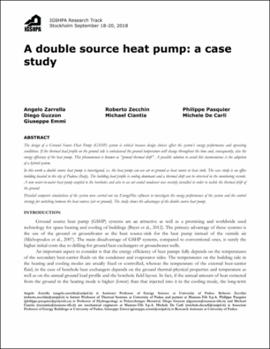| dc.contributor.author | Zarrella, Angelo | |
| dc.contributor.author | Zecchin, Roberto | |
| dc.contributor.author | Pasquier, Philippe | |
| dc.contributor.author | Guzzon, Diego | |
| dc.contributor.author | Ciantia, Michael | |
| dc.contributor.author | De Carli, Michele | |
| dc.contributor.author | Emmi, Giuseppe | |
| dc.contributor.other | IGSHPA Research Track (2018) | |
| dc.date.accessioned | 2018-08-28T17:59:03Z | |
| dc.date.available | 2018-08-28T17:59:03Z | |
| dc.date.issued | 2018 | |
| dc.identifier | oksd_ighspa_2018_zarrella | |
| dc.identifier.uri | https://hdl.handle.net/11244/301589 | |
| dc.description.abstract | The design of a Ground Source Heat Pump (GSHP) system is critical because design choices affect the system's energy performance and operating conditions. If the thermal load profile on the ground side is unbalanced the ground temperature will change throughout the time and, consequently, also the energy efficiency of the heat pump. This phenomenon is known as "ground thermal drift". A possible solution to avoid this inconvenience is the adoption of a hybrid system. | |
| dc.description.abstract | In this work a double source heat pump is investigated, i.e. the heat pump can use air or ground as heat source or heat sink. The case study is an office building located in the city of Padova (Italy). The building load profile is cooling dominant and a thermal drift can be observed in the monitoring records. A new water-to-water heat pump coupled to the boreholes and also to an air-cooled condenser was recently installed in order to tackle the thermal drift of the ground. | |
| dc.description.abstract | Detailed computer simulations of the system were carried out via EnergyPlus software to investigate the energy performance of the system and the control strategy for switching between the heat sources (air or ground). The study shows the advantages of the double source heat pump. | |
| dc.format | application/pdf | |
| dc.language | en_US | |
| dc.publisher | International Ground Source Heat Pump Association | |
| dc.rights | In the Oklahoma State University Library's institutional repository this paper is made available through the open access principles and the terms of agreement/consent between the author(s) and the publisher. The permission policy on the use, reproduction or distribution of the article falls under fair use for educational, scholarship, and research purposes. Contact Digital Resources and Discovery Services at lib-dls@okstate.edu or 405-744-9161 for further information. | |
| dc.title | Double source heat pump: A case study | |
| osu.filename | oksd_ighspa_2018_zarrella.pdf | |
| dc.identifier.doi | 10.22488/okstate.18.000049 | |
| dc.type.genre | Conference proceedings | |
| dc.type.material | Text | |
